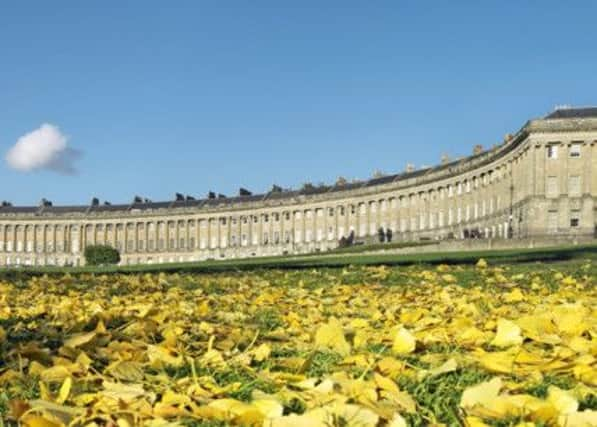Travel: By George, it’s good in Bath


Forget the Romans (although Emperor Claudius did do a fabulous job on those baths) because it’s all about King George (numbers I, II, III & IV) this year in Bath. It is 250 years since Georgian architects made Bath so aesthetically stunning and in 1987 it became the only city in Britain to gain World Heritage status. Indeed, I challenge anyone not to have their breath caught by a first glimpse of The Royal Crescent, especially as the low autumn sun settles on this elegant sweep of 30 houses built in creamy gold Bath stone.
CONNECT WITH THE SCOTSMAN
• Subscribe to our daily newsletter (requires registration) and get the latest news, sport and business headlines delivered to your inbox every morning
Advertisement
Hide AdHome for the weekend was number 16, The Royal Crescent Hotel & Spa, which encompasses two fine residences and five coach houses with lovely gardens in between. It is a gorgeous hotel, recently renovated but staying true to its history. There are peacock greens, duck-egg blues, coral pinks and striped wallpapers that Farrow & Ball would be proud to call their own, giving it a contemporary feel, but these are in fact copies of original Georgian schemes. There isn’t a hint of 18th century about its conveniences though, with power showers, digital televisions and wi-fi in every room.
Famous for its afternoon tea (with a plan to introduce a late afternoon option that includes canapés and cocktails soon), the hotel gets busy after lunch as visitors pop into The Dower House Restaurant to scoff cakes almost too pretty to eat. Among our sweet treats were pistachio sponges, strawberry tarts, blackcurrant macaroons and the obligatory Bath Bun, a sweet roll made from milky dough with its origins in the 18th century. We walked it off in Victoria Park just opposite, following the leaf-strewn paths to where the ice rink was being built for Christmas.
Most head to the Jane Austen Centre on Gay Street for a glimpse of life in 18th-century Bath and it is worth a visit if you’ve an interest in her writing – and in particular the two books she set here, Persuasion and Northanger Abbey – but it does feel a little faux. History buffs favour the more authentic No.1 Museum, the first house to be built on the Royal Crescent. Fitted out in period furniture it gives an honest view of life for Bath’s most fashionable residents.
It’s still easy to conjure up Jane Austen’s era (I half expected to see Emma Thompson sitting at the harpsichord) but beyond the lavish décor and fancy silverware you also get a glimpse of real life such as the lack of sanitation.
Dinner guests simply popped behind a screen in the corner of the dining room to relieve themselves. A fact, that according to our guide, never fails to shock American visitors.
There are lots of interesting options for dinner such as the informal Wild Café on Queen Street, with its cheeky marketing ploys: “The bestest full English I’ve had in town – Jane Austen.” It’s hard, though, to tear yourself away from the roaring log fires and sense of history that The Royal Crescent provides so I ordered mushroom broth and pheasant, which sounded appropriate to my surroundings, and settled in for a gastronomic night.
Advertisement
Hide AdOn Sunday we went off in search of the city’s other must-see Georgian splendours, happening first upon the sweetly named Margaret’s Buildings, a pretty pedestrianised street lined with interesting shops and galleries, including Liz Cox, Bath’s own luxury bag maker with beautiful handbags in crocodile embossed emerald green suede and plum calf’s leather. Just a couple of minutes’ walk from here is Circus, a circle of grand townhouses, modelled on Rome’s Colosseum, built between 1754 and 1768 (look for the faces of the vain original owners sculpted above the doors).
Until February there’s a fun exhibition, “Georgians: Dress for Polite Society”, at the Fashion Museum, housed in the magnificent Assembly Rooms, famous for its Pump House tea rooms. The 30 or more original gowns highlight just what a faff (not to mention hot during an age that wasn’t known for personal hygiene) it must have been for Miss Austen and her friends. If you’re really keen you can even get trussed up in a corset and crinoline.
SCOTSMAN TABLET AND IPHONE APPS
Advertisement
Hide AdWe popped into The Salamander Pub on John Street for a Bath Ale, sampling the Ginger Hare which we were told was perfect for winter with its blend of root ginger, hops and barley. We nibbled rich local Double Gloucester from the wonderful Paxton and Whitfield cheesemongers on Queen Square, another of Bath’s architectural highlights, and wandered the length of Queen Street, stopping at Scarlet Vintage. I felt that I should be on the look out for a bonnet with ribbons, but came away instead with a pair of 1950s purple suede gloves, feeling that the spirited Miss Jane Austen would have surely approved.
It seemed appropriate to enjoy a swim when visiting a famous spa town.
The relaxation area in the hotel spa is atmospheric, with thick stone walls and long chapel windows overlooking the garden. We swam in streams of late afternoon sunlight and soaked in the oak barrel hot tubs. Before leaving we just had time to drink a toast to all the King Georges with a glass of Ruinart Rosé champagne, which is also celebrating its 250th year.
A double room at The Royal Crescent Hotel (tel: 01225 823333, www.royalcrescent.co.uk) based on two people sharing and including breakfast starts at £230; a full afternoon tea is £26 per person,while a cream tea is £14.50. Admission to No.1 Royal Crescent costs £8.50 per adult; www.no1royalcrescent.org.uk. Admission to the Jane Austen Centre costs £8 per adult; www.janeausten.co.uk